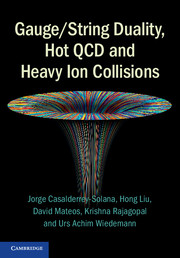Book contents
- Frontmatter
- Contents
- 1 Opening remarks
- 2 A heavy ion phenomenology primer
- 3 Results from lattice QCD at nonzero temperature
- 4 Introducing the gauge/string duality
- 5 A duality toolbox
- 6 Bulk properties of strongly coupled plasma
- 7 From hydrodynamics to far-from-equilibrium dynamics
- 8 Probing strongly coupled plasma
- 9 Quarkonium mesons in strongly coupled plasma
- 10 Concluding remarks and outlook
- Appendix A Green–Kubo formula for transport coefficients
- Appendix B Hawking temperature of a general black brane metric
- Appendix C Holographic renormalization, one-point functions, and a two-point function
- Appendix D Computation of the holographic stress tensor
- References
- Index
4 - Introducing the gauge/string duality
Published online by Cambridge University Press: 05 July 2014
- Frontmatter
- Contents
- 1 Opening remarks
- 2 A heavy ion phenomenology primer
- 3 Results from lattice QCD at nonzero temperature
- 4 Introducing the gauge/string duality
- 5 A duality toolbox
- 6 Bulk properties of strongly coupled plasma
- 7 From hydrodynamics to far-from-equilibrium dynamics
- 8 Probing strongly coupled plasma
- 9 Quarkonium mesons in strongly coupled plasma
- 10 Concluding remarks and outlook
- Appendix A Green–Kubo formula for transport coefficients
- Appendix B Hawking temperature of a general black brane metric
- Appendix C Holographic renormalization, one-point functions, and a two-point function
- Appendix D Computation of the holographic stress tensor
- References
- Index
Summary
Chapters 4 and 5 together constitute a primer on gauge/string duality, written for a QCD audience.
Our goal in this section is to state what we mean by gauge/string duality, via a clear statement of the original example of such a duality [594, 392, 803], namely the conjectured equivalence between a certain conformal gauge theory and a certain gravitational theory in anti-de Sitter (AdS) spacetime. We shall do this in Section 4.3. In order to get there, in Section 4.1 we will first motivate from a gauge theory perspective why there must be such a duality. Then, in Section 4.2, we will give the reader a look at all that one needs to know about string theory itself in order to understand Section 4.3, and indeed to read this book.
Since some of the contents of this chapter are by now standard textbook material, in some cases we will not give specific references. The reader interested in a more detailed review of string theory may consult the many textbooks available such as [386, 587, 685, 501, 823, 532, 133, 321]. The reader interested in complementary aspects or extra details about the gauge/string duality may consult some of the many existing reviews, e.g. [29, 319, 596, 749, 672, 601, 340, 398, 730, 687].
Motivating the duality
Although the AdS/CFT correspondence was originally discovered [594, 392, 803] by studying D-branes and black holes in string theory, the fact that such an equivalence may exist can be directly motivated from certain aspects of gauge theories and gravity. In this section we motivate such a direct path from gauge theory to string theory without going into any details about string theory and D-branes.
- Type
- Chapter
- Information
- Gauge/String Duality, Hot QCD and Heavy Ion Collisions , pp. 92 - 110Publisher: Cambridge University PressPrint publication year: 2014



